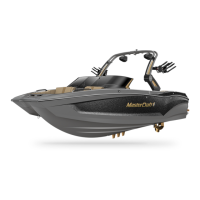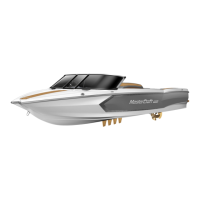2005 MASTERCRAFT OWNERS MANUAL–PAG E 2-1
THE
COMMON
SENSE
APPROACH
> > > > > >
This manual have been developed to help ensure an enjoyable experience as you boat, wakeboard and ski with your
MasterCraft boat. As stated earlier, this information is not all-inclusive. There are many other factors to consider and addi-
tional information that you need to research before undertaking any boating.
Beyond the study involved, you should also always use common sense when boating. For example, when anchoring your
boat so that you can enjoy swimming, you MUST turn the engine OFF. Exhaust fumes are emitted from the exhaust flap area of the
transom, immediately below the swim platform. No one should ever be on the swim platform while the engine is in operation. Nor
should individuals ever be towed while holding on to the swim platform or transom.
MasterCraft also strongly encourages individuals to wear Personal Flotation Devices (PFDs). In many states, it is a legal
requirement for children to wear them. Non-swimmers of any age should never be without one.
Your MasterCraft boat can be the source of countless hours of family fun and building friendships. But it works only if YOU
use your head before, during and after your boating.
Now, finish reading this manual and then go out there and HAVE SOME FUN!
Carbon monoxide is a colorless, tasteless, odorless and poisonous gas that accumulates rapidly and can
cause serious injury or death. Exposure to carbon monoxide can be fatal in a matter of minutes. Exposure to
even low concentrations of carbon monoxide must not be ignored because the effects of exposure to carbon
monoxide are cumulative and can be just as lethal as at high concentrations. Carbon monoxide from exhaust
pipes of inboard or outboard engines may build up inside and outside the boat in areas near exhaust vents.
STAY AWAY from these exhaust vent areas, which are located at the stern of the boat, and DO NOT swim or
engage in any watersports or other activties in or near the stern area of the boat, including, without limitation,
the swim platform and the rear sun deck, when the engine is in operation. Under no circumstances should “teak surfing”
or similar activities be performed during the operation of your MasterCraft boat–such activities are a misuse of this product.

